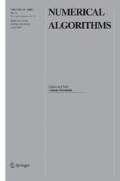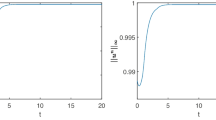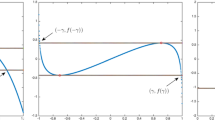Abstract
We put forward and analyze the high-order (up to fourth) strong stability-preserving implicit-explicit Runge-Kutta schemes for the time integration of the space-fractional Allen-Cahn equation, which inherits the maximum principle preserving and energy stability. The space-fractional Allen-Cahn equation with homogeneous Dirichlet boundary condition is first discretized in the spatial direction by using a second-order fractional centered difference scheme that preserves the semi-discrete maximum principle. It is subsequently integrated in the temporal direction by a class of strong stability-preserving implicit-explicit Runge-Kutta schemes that are specifically designed to preserve the maximum principle to the optimal time step size. The convergence order in the discrete \(L^{\infty }\) norm and energy boundedness are provided by using the established maximum principle. Finally, a series of numerical experiments are carried out to demonstrate the high-order convergence, maximum principle preserving, and energy stability of the proposed schemes.









Similar content being viewed by others
References
Akagi, G., Schimperna, G., Segatti, A.: Fractional Cahn–Hilliard, Allen–Cahn and porous medium equations. Journal of Differential Equations 261 (6), 2935–2985 (2016)
Ascher, U.M., Ruuth, S.J., Spiteri, R.J.: Implicit-explicit Runge-Kutta methods for time-dependent partial differential equations. Appl. Numer. Math. 25(2-3), 151–167 (1997)
Bueno-Orovio, A., Kay, D., Burrage, K.: Fourier spectral methods for fractional-in-space reaction-diffusion equations. BIT Numerical Mathematics 54(4), 937–954 (2014)
Burrage, K., Hale, N., Kay, D.: An efficient implicit FEM scheme for fractional-in-space reaction-diffusion equations. SIAM J. Sci. Comput. 34(4), A2145–A2172 (2012)
Çelik, C., Duman, M.: Crank–nicolson method for the fractional diffusion equation with the Riesz fractional derivative. Journal of Computational Physics 231(4), 1743–1750 (2012)
Celledoni, E., Grimm, V., McLachlan, R.I., McLaren, D., O’Neale, D., Owren, B., Quispel, G.: Preserving energy resp. dissipation in numerical PDEs using the Average Vector Field method. J. Comput. Phys. 231 (20), 6770–6789 (2012)
Chan, R.H.F., Jin, X.Q.: An introduction to iterative Toeplitz solvers. SIAM (2007)
Chen, C., Yang, X.: Efficient numerical scheme for a dendritic solidification phase field model with melt convection. J. Comput. Phys. 388, 41–62 (2019)
Cheng, Q.: The generalized scalar auxiliary variable approach (G-SAV) for gradient flows. arXiv:2002.00236 (2020)
Cheng, Q., Shen, J., Yang, X.: Highly efficient and accurate numerical schemes for the epitaxial thin film growth models by using the SAV approach. J. Sci. Comput. 78(3), 1467–1487 (2019)
Choi, J.W., Lee, H.G., Jeong, D., Kim, J.: An unconditionally gradient stable numerical method for solving the Allen–Cahn equation. Physica A: Statistical Mechanics and its Applications 388(9), 1791–1803 (2009)
Conde, S., Gottlieb, S., Grant, Z.J., Shadid, J.N.: Implicit and implicit–explicit strong stability preserving runge–kutta methods with high linear order. J. Sci. Comput. 73(2-3), 667–690 (2017)
Du, Q., Ju, L., Li, X., Qiao, Z.: Maximum principle preserving exponential time differencing schemes for the nonlocal Allen–Cahn equation. SIAM J. Numer. Anal. 57(2), 875–898 (2019)
Du, Q., Ju, L., Li, X., Qiao, Z.: Maximum bound principles for a class of semilinear parabolic equations and exponential time differencing schemes. arXiv:2005.11465 (2020)
Du, Q., Ju, L., Lu, J.: Analysis of fully discrete approximations for dissipative systems and application to time-dependent nonlocal diffusion problems. J. Sci. Comput. 78(3), 1438–1466 (2019)
Evans, L.C., Soner, H.M., Souganidis, P.E.: Phase transitions and generalized motion by mean curvature. Commun. Pure Appl. Math. 45 (9), 1097–1123 (1992)
Eyre, D.J.: An unconditionally stable one-step scheme for gradient systems. Unpublished article, pp 1–15 (1998)
Ferracina, L., Spijker, M.N.: Stepsize restrictions for the total-variation-diminishing property in general Runge–Kutta methods. SIAM Journal on Numerical Analysis 42(3), 1073–1093 (2004)
Gong, Y., Zhao, J., Wang, Q.: Arbitrarily high-order unconditionally energy stable schemes for gradient flow models using the scalar auxiliary variable approach. arXiv:1907.04254 (2019)
Gu, X.M., Huang, T.Z., Carpentieri, B., Li, L., Wen, C.: A hybridized iterative algorithm of the biCORSTAB and GPBiCOR methods for solving non-Hermitian linear systems. Computers & Mathematics with Applications 70(12), 3019–3031 (2015)
Gu, X.M., Huang, T.Z., Li, H.B., Li, L., Luo, W.H.: On k-step CSCS-based polynomial preconditioners for Toeplitz linear systems with application to fractional diffusion equations. Appl. Math. Lett. 42, 53–58 (2015)
He, D., Pan, K., Hu, H.: A spatial fourth-order maximum principle preserving operator splitting scheme for the multi-dimensional fractional Allen-Cahn equation. Appl. Numer. Math. 151, 44–63 (2020)
Higueras, I.: Characterizing strong stability preserving additive Runge-Kutta methods. J. Sci. Comput. 39(1), 115–128 (2009)
Higueras, I., Happenhofer, N., Koch, O., Kupka, F.: Optimized strong stability preserving IMEX Runge–Kutta methods. J. Comput. Appl. Math. 272, 116–140 (2014)
Hou, T., Leng, H.: Numerical analysis of a stabilized Crank–Nicolson/Adams–Bashforth finite difference scheme for Allen–Cahn equations. Appl. Math. Lett. 102, 106150 (2020)
Hou, T., Tang, T., Yang, J.: Numerical analysis of fully discretized Crank–Nicolson scheme for fractional-in-space Allen–Cahn equations. J. Sci. Comput. 72(3), 1214–1231 (2017)
Hou, T., Xiu, D., Jiang, W.: A new second-order maximum-principle preserving finite difference scheme for Allen–Cahn equations with periodic boundary conditions. Appl. Math. Lett. 104, 106265 (2020)
Liao, H.L., Tang, T., Zhou, T.: A second-order and nonuniform time-stepping maximum-principle preserving scheme for time-fractional Allen-Cahn equations. arXiv:1909.10216 (2019)
Liu, Z., Li, X.: Efficient modified stabilized invariant energy quadratization approaches for phase-field crystal equation is published in Numerical Algorithms volume 85, pages 107–132. https://link.springer.com/article/10.1007/s11075-019-00804-9(2020)
Liu, Z., Li, X.: Step-by-step solving schemes based on scalar auxiliary variable and invariant energy quadratization approaches for gradient flows. arXiv:2001.00812 (2019)
Meerschaert, M.M., Tadjeran, C.: Finite difference approximations for fractional advection–dispersion flow equations. Journal of Computational and Applied Mathematics 172(1), 65–77 (2004)
Nec, Y., Nepomnyashchy, A., Golovin, A.: Front-type solutions of fractional Allen–Cahn equation. Physica D: Nonlinear Phenomena 237 (24), 3237–3251 (2008)
Ortigueira, M.D.: Riesz potential operators and inverses via fractional centred derivatives. Int. J. Math. Math. Sci. 2006 (2006)
Palatucci, G., Savin, O., Valdinoci, E.: Local and global minimizers for a variational energy involving a fractional norm. Annali di matematica pura ed applicata 192(4), 673–718 (2013)
Podlubny, I.: Fractional Differential Equations, Vol. 198 of Mathematics in Science and Engineering. Academic Press, San Diego, California, USA (1999)
Shen, J., Tang, T., Yang, J.: On the maximum principle preserving schemes for the generalized Allen–Cahn equation. Commun. Math. Sci. 14(6), 1517–1534 (2016)
Shen, J., Xu, J.: Convergence and error analysis for the scalar auxiliary variable (SAV) schemes to gradient flows. SIAM J. Numer. Anal. 56(5), 2895–2912 (2018)
Shen, J., Xu, J., Yang, J.: The scalar auxiliary variable (SAV) approach for gradient flows. J. Comput. Phys. 353, 407–416 (2018)
Song, H.: Energy SSP-IMEX Runge–Kutta methods for the Cahn–Hilliard equation. J. Comput. Appl. Math. 292, 576–590 (2016)
Tang, T., Qiao, Z.: Efficient numerical methods for phase-field equations. SCIENTIA SINICA Mathematica 50(6), 775 (2020)
Tang, T., Yang, J.: Implicit-explicit scheme for the Allen-Cahn equation preserves the maximum principle. J. Comput. Math 34(5), 471–481 (2016)
Tian, W., Zhou, H., Deng, W.: A class of second order difference approximations for solving space fractional diffusion equations. Math. Comput. 84(294), 1703–1727 (2015)
Wang, H., Shu, C.W., Zhang, Q.: Stability and error estimates of local discontinuous Galerkin methods with implicit-explicit time-marching for advection-diffusion problems. SIAM J. Numer. Anal. 53(1), 206–227 (2015)
Xiao, X., He, R., Feng, X.: Unconditionally maximum principle preserving finite element schemes for the surface Allen–Cahn type equations. Numerical Methods for Partial Differential Equations 36(2), 418–438 (2020)
Yang, J., Du, Q., Zhang, W.: Uniform lp-bound of the Allen-Cahn equation and its numerical discretization. International Journal of Numerical Analysis & Modeling 15(1-2), 213–227 (2018)
Yang, X.: Linear, first and second-order, unconditionally energy stable numerical schemes for the phase field model of homopolymer blends. J. Comput. Phys. 327, 294–316 (2016)
Yang, X., Zhang, G.D.: Convergence analysis for the invariant energy quadratization (IEQ) schemes for solving the Cahn–Hilliard and Allen–Cahn equations with general nonlinear potential. J. Sci. Comput. 82(3), 1–28 (2020)
Yang, Z., Dong, S.: A roadmap for discretely energy-stable schemes for dissipative systems based on a generalized auxiliary variable with guaranteed positivity. J. Comput. Phys. 404, 109121 (2020)
Zhai, S., Ye, C., Weng, Z.: A fast and efficient numerical algorithm for fractional Allen–Cahn with precise nonlocal mass conservation. Appl. Math. Lett. 103, 106190 (2020)
Zhang, H., Yan, J., Qian, X., Song, S.: Numerical analysis and applications of explicit high order maximum principle preserving integrating factor runge-kutta schemes for allen-cahn equation. Applied Numerical Mathematics (2020)
Zhang, Q., Li, T.: Asymptotic stability of compact and linear 𝜃-methods for space fractional delay generalized diffusion equation. J. Sci. Comput. 81(3), 2413–2446 (2019)
Acknowledgements
H. Zhang would like to thank “user1551” in https://math.stackexchange.com/questions/3769352for the proof of Lemma 2.3.
Funding
This work was supported by the National Key R&D Program of China (SQ2020YFA070075), the National Natural Science Foundation of China (No. 11901577, 11971481, 12071481), the Natural Science Foundation of Hunan (No. S2017JJQNJJ0764, 2020JJ5652), the fund from Hunan Provincial Key Laboratory of Mathematical Modeling and Analysis in Engineering (No. 2018MMAEZD004), the Research Fund of National University of Defense Technology (No. ZK19-37) and the Basic Research Foundation of National Numerical Wind Tunnel Project (No. NNW2018-ZT4A08).
Author information
Authors and Affiliations
Corresponding author
Additional information
Publisher’s note
Springer Nature remains neutral with regard to jurisdictional claims in published maps and institutional affiliations.
Appendix:: Coefficients of some IMEX Runge-Kutta methods
Appendix:: Coefficients of some IMEX Runge-Kutta methods
-
1.
Optimized SSP2222 (K = 1)
$$ \begin{aligned} A & = \left[ \begin{array}{cc} 0 & 0 \\ 1 & 0 \end{array} \right],\\ b & = \left[ \begin{array}{cc} 0.5 & 0.5 \end{array} \right]^{T}, \\ \tilde A & = \left[ \begin{array}{cc} 0 & 0 \\ 0 & 1 \end{array}\right] \\ \tilde b &= b. \end{aligned} $$ -
2.
Optimized SSP3333 (K = 1)
$$ \begin{aligned} A &= \left[ \begin{array}{cccc} 0 & 0 & 0\\ 0.835696619896941& 0 & 0 \\ 0.206998613430894& 0.359713233559212 & 0 \end{array} \right], \\ b &= \left[ \begin{array}{ccc} 0.223244212531201& 0.222329659694216 & 0.554426127774583 \end{array} \right]^{T}, \\ \tilde A &= \left[ \begin{array}{cccc} 0 & 0 & 0\\ 0.626996630922690& 0.208699988974251& 0\\ 0.184038115921842& 0.051324585660262 & 0.331349145408003 \end{array} \right], \\ \tilde b &= b. \end{aligned} $$ -
3.
Optimized SSP4334 (K = 1)
$$ \begin{aligned} A &= \left[ \begin{array}{cccc} 0 & 0 & 0 & 0 \\ 0.450747108014309 & 0 & 0 & 0 \\ 0.176334489487884 & 0.489006055228990 & 0 &0 \\ 0.205978444248877 & 0.153461952023751 & 0.371692342116013 & 0 \end{array} \right], \\ b &= \left[ \begin{array}{cccc} 0.232713406461542 & 0.138692626440902 & 0.335920229077949 & 0.292673738019606 \end{array} \right]^{T}, \\ \tilde A &= \left[ \begin{array}{cccc} 0& 0 &0 & 0 \\ 0.278199085980253 & 0.172548022034056 & 0 & 0 \\ 0.311223289933055 & 0.067501647574067 & 0.286615607209751 & 0 \\ 0.245782336194099 & 0.248157968208214 & 0.098290863121270 & 0.138901570865059 \end{array} \right], \\ \tilde b &= \left[ \begin{array}{cccc} 0.222127817205699 & 0.224274752530891 & 0.088831226489934 & 0.464766203773476 \end{array} \right]^{T}. \end{aligned} $$ -
4.
Optimized SSP5444 (K = 1)
$$ \begin{aligned} A &= \left[ \begin{array}{ccccc} 0 & 0 & 0 & 0 & 0\\ 0.315011539134757& 0 & 0 & 0 & 0 \\ 0.092321902233778 &0.445552754571477&0 & 0 &0\\ 0.075770251330566 & 0.114390152779218& 0.390310565760801 &0 &0\\ 0.173751459170420 & 0.132589347012580& 0.196012450887862 & 0.457940007330246 & 0 \end{array} \right], \\b & = \left[ \begin{array}{ccccc} 0.133025520352077 & 0.255101129886359 &0.140292259141287& 0.286122212426944& 0.185458878193333 \end{array} \right]^{T},\\ \tilde A & = \left[ \begin{array}{ccccc} 0& 0 & 0& 0 & 0 \\ 0.196366311461557 & 0.118645227673200 & 0& 0 &0\\ 0.256502494758585 &0.034771904397118 &0.246600257649552 &0 &0\\ 0.124682224052501 &0.279820872038586 & 0.063311571463197 & 0.112656302316301 & 0 \\ 0.105880545237959 &0.146474778500675&0.329779897287268&0.361855954830076 & 0.016302088545130 \end{array} \right], \\ \tilde b & = b. \end{aligned} $$
Rights and permissions
About this article
Cite this article
Zhang, H., Yan, J., Qian, X. et al. On the preserving of the maximum principle and energy stability of high-order implicit-explicit Runge-Kutta schemes for the space-fractional Allen-Cahn equation. Numer Algor 88, 1309–1336 (2021). https://doi.org/10.1007/s11075-021-01077-x
Received:
Accepted:
Published:
Issue Date:
DOI: https://doi.org/10.1007/s11075-021-01077-x
Keywords
- Space-fractional Allen-Cahn equation
- Maximum principle preserving
- Strong stability-preserving implicit-explicit Runge-Kutta scheme
- Energy stability




